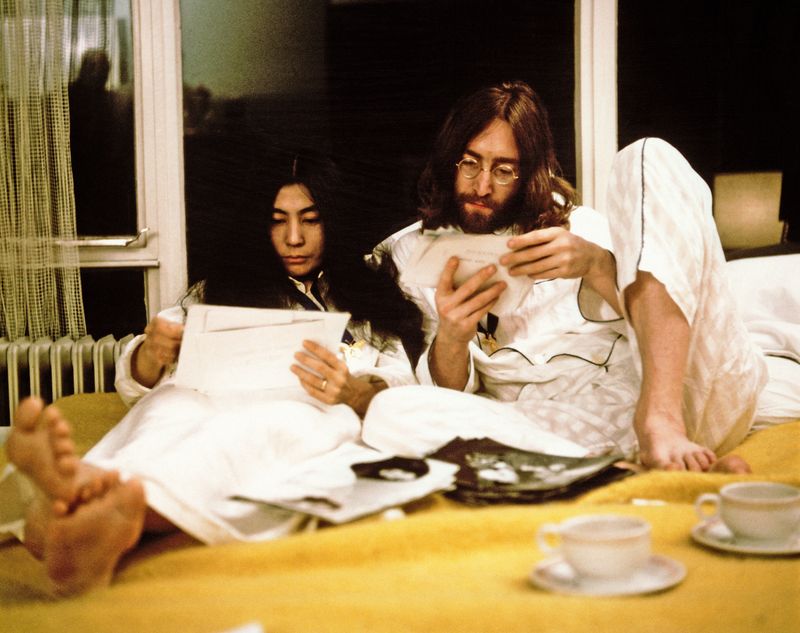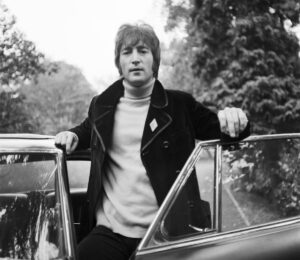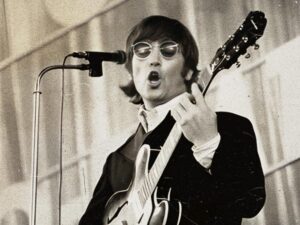Although Yoko Ono became world famous in the late 1960s after kindling a romantic bond with The Beatles’ bespectacled genius John Lennon, she had begun a successful career in the arts earlier in the decade. After all, it was through art that these kindred spirits born on opposite sides of the world first met.
Before she met Lennon, Ono’s first encounter with a Beatle was with Paul McCartney. She visited the Beatle at his London address to obtain a Lennon-McCartney song manuscript for John Cage, who was writing his book Notations at the time. McCartney politely declined but suggested that Lennon might oblige the request.
Lennon later consented, handing Ono the handwritten lyrics to his song ‘The Word’. However, by this point, the pair had already bumped into one another in November 1966 at the Indica Gallery in London, where Ono had been hosting an art exhibition.
Among Ono’s conceptual art pieces was Hammer a Nail, an installation inviting viewers to hammer a nail into a white wooden board. Ono hadn’t yet opened the exhibition to participants, but Lennon was enticed. As he moved to hammer the nail, Ono stopped him, explaining that it wasn’t ready yet.
The gallery owner, John Dunbar, asked her, “Don’t you know who this is? He’s a millionaire! He might buy it.” Ono kept her cool, pretending to be oblivious and finally allowed Lennon to hammer the nail on the condition that he hand her five shillings. In response, Lennon suavely quipped, “I’ll give you an imaginary five shillings and hammer an imaginary nail in,” via David Sheff’s All We Are Saying: The Last Major Interview with John Lennon and Yoko Ono.
In 2007, Ono opened the Imagine Peace Tower on Viðey Island in Kollafjörður Bay in Iceland. The impressive “light house” structure was erected as a memorial to Lennon. It consists of a tall tower of light formed by multiple beams projected skyward from a white stone monument with the phrase ‘Imagine Peace’ engraved into it in 24 languages.
As you may have guessed, the tower pertains to Lennon and Ono’s famous peace campaigns, which included the couple’s famous Bed-Ins of 1969. Although the tower was erected in 2007, the conceptual inception had occurred some four decades before in an exhibition at the Indica Gallery, where Ono and Lennon first met.
“In 1965, I put the light house down as part of the sales list in my book Grapefruit,” Ono remembered in a 2007 interview feature with Uncut. “In 1966, I put some prisms in the Indica Art Gallery as part of the light house. I met John there, and in 1967, he invited me to his house, Kenwood, to talk about it. It was funny: the light house was conceptual, and it took John to visualise it. Now it’s a reality.
“About three years ago, I had to think about what to do with all the wishes that people tied to the wish trees at my museum shows. We have more than a million wishes. I thought, ‘I need a tower.’ Then I thought, ‘Oh… that should be John’s light tower.’ The light stands for empowerment and for energy, and wisdom. The wishes will be buried around the tower in capsules.”
Continuing, Ono discussed the monument’s link to Lennon’s music. “It’s called Imagine Peace Tower because the word ‘imagine’ was a very important word between us,” she said. “It’s very special because of John’s song ‘Imagine’, as well. I was there when he wrote it. We were in Ascot, in our bedroom upstairs. Because we were both artists, we showed each other everything. If I scribbled something, I’d show it to John. He would scribble something and show it to me. That’s how he wrote his songs, too. He wasn’t one of those writers who’d write from ten until 12 in the morning. He used to think of an idea when we were in a plane or something. He just writes it down. And at the time he writes it down, he’s already got the melody”.
“John didn’t have a narrow talent. He had all the different emotions he was able to express in his songs. If you want to analyse it, his mum wasn’t around, and his dad wasn’t around, and he wanted someone to listen to him when he was a little boy. When I went to Liverpool, to his childhood home, I cried because I saw the little bedroom where it all started.”
“‘Imagine’ is my favourite of John’s peace songs,” Ono later affirmed. “I think he thought just like I do now – world peace is an inevitable thing. What are we going to do? Kill ourselves? We’re not that dumb.”
Having picked out ‘Imagine’ as a particular favourite, Ono opined that, although Lennon brought transparency to the peace agenda in his 1970s solo career, his peace writing had begun during the Beatles’ psychedelic era in the late ’60s.
“I think ‘All You Need Is Love’ was the beginning of John’s peace writing,” she said. “You notice that even when he was a Beatle, he wanted to dabble in different things, especially anti-war songs. But The Beatles were so successful he felt he couldn’t.”
“‘Give Peace A Chance’ is basically John’s idea,” Ono finally added, picking out another of Lennon’s powerful peace songs. “I might have thrown some words in. It happened spontaneously in the hotel room [Montreal’s Queen Elizabeth Hotel, during the 1969 Bed-In]. I thought it was great. But, you know, it’s a political song. When John writes something extremely artistic like ‘Scared ‘, that’s a different story. I really admire it; it’s fantastic. But with ‘Give Peace A Chance’, it’s very important when you try to communicate on a very wide level. You have to choose very simple but powerful words to get the message across.”
In February 2023, Yoko Ono celebrated her 90th birthday. Ono remains a champion of the peace campaign she and Lennon established over five decades ago. Sadly, the message shows no sign of impending redundancy in the modern climate.
Listen to the Plastic Ono Band’s anti-war anthem, ‘Give Peace a Chance’, below.



